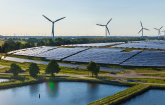Next-Generation geothermal energy has technical potential to supply 150 times current global annual electricity demand, report finds
BOSTON, Dec. 13, 2024 /PRNewswire/ -- Using data and foundational analysis provided by Project InnerSpace, the International Energy Agency (IEA) published today The Future of Geothermal Energy, a watershed report that found that next-generation geothermal technologies "have the technical potential to meet global electricity and heat demand many times over" at costs by 2035 that would make geothermal cheaper than nuclear and competitive with solar photovoltaics (PV) and wind paired with energy storage. Today, geothermal meets about one percent of energy demand.
To provide IEA with analysis underpinning the results reflected in the report, the Project InnerSpace team utilized subsurface data from its freely accessible and philanthropically funded GeoMap geothermal prospecting tool to create a model estimating both electricity and heat potential across the globe.
Geothermal, the heat inside the Earth's crust, is a firm, clean, always-on and scalable source for power and heat with a small surface footprint that uses skills and technologies from an existing oil and gas workforce. Until recently it has been unrepresented in global conversations about energy and climate because its traditional geographic scope is limited. However, recent innovations in drilling technology developed and deployed by the oil and gas industry are unlocking geothermal's vast potential. This expanded geographic scope is the driver behind the massive estimates for growth in the IEA Report.
"We are not surprised about the outcome of the IEA analysis. The potential of geothermal worldwide is massive," noted Drew Nelson, VP of Programs, Policy, and Strategy at Project InnerSpace. "A fundamental basis for our theory of change at InnerSpace is the prospect that the speed and scale of the oil and gas industry can pull geothermal quickly into the mainstream. This report should be a clear signal to policymakers and stakeholders across the globe that next-generation geothermal has arrived, is ready to deploy, and could grow to meet as much as 33% of the world's energy demand by 2050."
Geothermal project costs are already coming down due to oil and gas engagement in the space. At a U.S. Department of Energy geothermal test site in Utah, drilling costs plunged 20% when oil and gas expertise was deployed, and costs dropped 50% at a neighboring geothermal pilot using similar methods.
Rapid adoption of enhanced geothermal systems to power data centers will likely drive costs even lower in coming years. Technology companies Meta and Google have turned to geothermal start-ups – and are willing to pay a premium – to power their data centers with next-generation geothermal energy, paving the way for more investment in technology and development. As more projects are deployed, they become cheaper, helping to unlock the potential outlined in this landmark IEA Report.
Other key findings from the IEA report include:
- Globally, the amount of electricity that could be technically generated by EGSs for less than USD 300 per megawatt-hour (MWh) is about 600 terawatt (TW) of geothermal capacity, or roughly 60 times current global electricity demand.
- Growth in geothermal is expected to create 1 million jobs by 2035 and drive $2.5 trillion in investment by 2050.
- The United States has the world's largest technical enhanced geothermal capacity potential. Even at a depth of 5 km, US technical potential is over 7 TW, seven times more than the country's total installed power capacity today.
- Geothermal could economically provide heat for about 35% of global industrial demand for heat below 200°C, saving about 750 Mt of CO2 emissions per year (equivalent to the annual emissions of Canada, the world's 12th largest emitter).
GeoMap, which provided the underlying data and supported the analysis in the IEA Report, is a philanthropically funded initiative of Project InnerSpace that supports more than 80 researchers and scientists around the world to build this freely available and first-of-its-kind global map of geothermal resources and potential.
Access the Project InnerSpace GeoMap tool here.
Read the complete report from the IEA here.
About Project InnerSpace: Project InnerSpace is the leading independent non-profit organization dedicated to the global development of geothermal energy. Our mission is to remove the barriers to the exponential growth and development of geothermal energy worldwide by 2030. Project InnerSpace has been named among the highest impact non-profits working in climate for two years in a row by both Vox and Giving Green.
SOURCE Project InnerSpace

WANT YOUR COMPANY'S NEWS FEATURED ON PRNEWSWIRE.COM?
Newsrooms &
Influencers
Digital Media
Outlets
Journalists
Opted In






Share this article